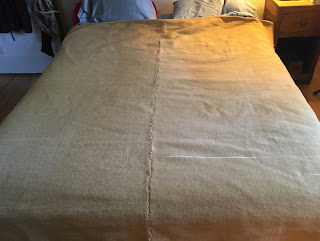I love the saying about not sending the fox to guard the henhouse. There seems to be a lot of that going on, although that has been true, always. The idiom about the sly fox and the hens goes back at least to the late 1500s.
 |
Guineas roosting at Los Poblanos,
in the North Valley of Albuquerque |
Our dear neighbor in Texas, Jake Goodson, had laying hens. And as much as he tried to have a flock of guineas (technically called a “confusion”, the term for a bunch of guineas), he had little to no success. I think guineas are pretty, and I love the way they scatter and chatter when a vehicle pulls into the yard, that is, if they run loose in yard, like they do in so many country places. Some would say that guineas behave like a bunch of idiots. In an attempt to protect his guineas, Jake would put them in a “secure” coop at night, which turned out not to be so secure. Varmints dug under the bottom of the pen, and so the story goes.

Jake was a friend and in some ways like an older brother to us all though the 1980s until our mother’s death in 2007. About that time Jake started having memory challenges, which ultimately took him to Alzheimer’s care a few years ago. Jake, whose Christian name was James Henry Goodson, went to his own reward a few weeks ago. Thoughts of him, his guineas, the fox in the henhouse, and so much more, are precious. Rest in Peace James Henry Goodson (October 5, 1929-January 13, 2019).

 Jake was a friend and in some ways like an older brother to us all though the 1980s until our mother’s death in 2007. About that time Jake started having memory challenges, which ultimately took him to Alzheimer’s care a few years ago. Jake, whose Christian name was James Henry Goodson, went to his own reward a few weeks ago. Thoughts of him, his guineas, the fox in the henhouse, and so much more, are precious. Rest in Peace James Henry Goodson (October 5, 1929-January 13, 2019).
Jake was a friend and in some ways like an older brother to us all though the 1980s until our mother’s death in 2007. About that time Jake started having memory challenges, which ultimately took him to Alzheimer’s care a few years ago. Jake, whose Christian name was James Henry Goodson, went to his own reward a few weeks ago. Thoughts of him, his guineas, the fox in the henhouse, and so much more, are precious. Rest in Peace James Henry Goodson (October 5, 1929-January 13, 2019).























